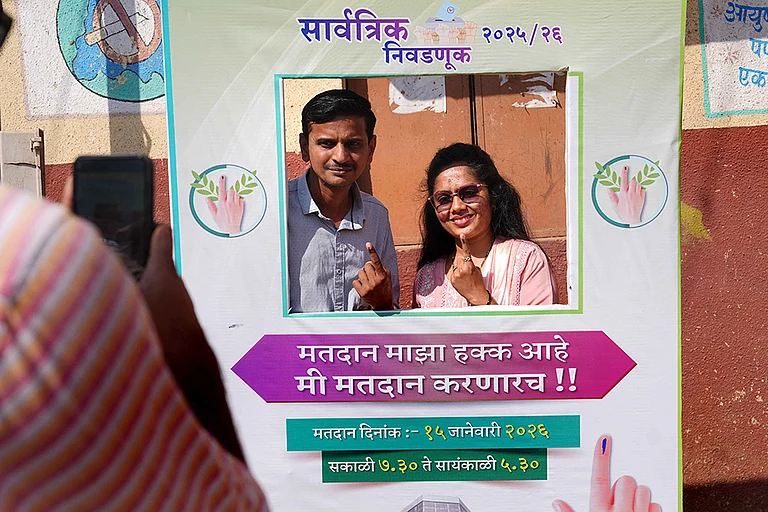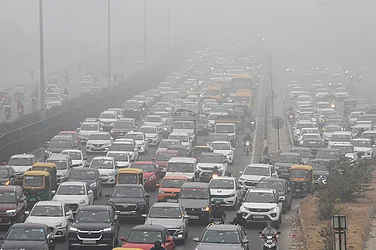On a rainy day in July, over half a dozen men have gathered at the Rashtriya Swayamsevak Sangh’s (RSS’) shakha at a posh south Delhi locality. The sky is overcast and the ground is wet and muddy.
“We usually have a gathering of around 50 men here, but the attendance is low today due to the rains,” says Saurabh Goyal, who is associated with Sangh’s kutumba prabodhan, RK Puram branch. Organised with an aim to strengthen family ties, such parivar (family) shakhas are held once a month alongside frequent big and small events in different localities.
This particular shakha is for the praudhs (senior citizens)—all gathered are above 40. Goyal is accompanied by Lal Singh, another kutumba prabodhan delegate, associated with the Sangh since 1970. Also present are Atul Tiwari, a technical officer at the Cabinet Secretariat, Neel Kumar, a former governing board member at DAV School, and Amit, a journalist by profession among other businessmen and retired men. They all sing a song.
“Har baala devi ki pratima, bachcha bachcha Ram hai, jahan sinh ban gaye khilaune, gaay jahan maa pyari hai” (Each girl is a female deity, each boy a Ram.. where lions became toys and cows are loved as mothers).
Afterwards, they take a pledge of “namaste sada”, an allegiance to the Hindu Rashtra. “To instigate strong emotions of nationalism and patriotism among people through different means of sports, games, and other activities is the Sangh’s primary agenda,” says a shakha member.
Following a ban on the RSS in 1948 after Mahatma Gandhi’s assassination, with Sardar Patel labelling it “a terror outfit”, the RSS realised that it required political representation, which led to the formation of Bharatiya Jan Sangh, the predecessor to the Bharatiya Janata Party (BJP). Madhav Sadashivrao Golwalkar, renowned as guruji, the second top leader of RSS, sent forward Pandit Deendayal Upadhyaya and Shyama Prasad Mukherjee to attain this agenda. And they were successful.
Over the years, with 52 organisations coming together and working directly or indirectly under the ambit of “Mother Organisation RSS”, the BJP-RSS parivar has forged a successful re-imagination of the constructive role of emotions in building the political community, within and beyond India. As a social organisation, the RSS has seeped into the realms of family, religion, and education. This is how the RSS, over a period of time, has initiated parivar prabodhan to come into play.
“Every time society is going through a crisis, the Sangh steps in to intervene. It was in 2007 that a top RSS leader felt that our society’s family structure was breaking due to a communication gap. He proposed the idea of kutumba prabodhan,” says Goyal. Also referred to as parivar prabodhan, it’s a set of activities, including social events and gatherings, meant to incorporate Sanatan ethics and morals among Indian families, precisely Hindu upper caste families.
This multifold approach of the Sangh operates under well-designed machinery. The Prabodhan works are categorised under three heads—Sangathan (holding shakhas), Jagran (providing service) and Sampark (reaching to the intellectuals, upper-middle-class, and then the masses).
Despite marginalised regional parties and the Opposition, the Right has kept the systemic cynicism afloat by ensuring that it is seen to overlap with relatively more credible and organic institutions such as family, nation, religion, and the armed forces.
On the basis of geography, the RSS has divided Delhi into eight vibhags, 30 jilas (districts) and 182 nagars (towns) for the structural functioning of its affiliates and activities. “Nagar karyakarinis (workers) in each nagar function in coordination with each other. In Delhi, the RSS runs five kinds of activities which include kutumba or parivar prabodhan, gau sewa, samajik samrasta, samajik sadbhav etc,” informs Goyal.
Another incentivisation is the titles that the RSS confers to those it aims to converge through its work. These titles generate a feeling of belongingness, responsibility and authority. Those holding grih sabhas are asked to encourage their neighbours to also hold them. Upon succeeding, we make them ‘pariwar mitra’ (family friends). “That’s how the chain grows,” says one of the members, adding that the true ways of a Sanatan family are reflected in the presence of a Tulsi (Holy Basil) plant, a dhwaja (flag), mandir (temple), dhoop-agarbatti (incense sticks), and how one celebrates birthdays.
“Irrespective of the events, functions and programmes, we only have one focus just as Arjuna (mythological character from Mahabharata), that is, to perpetuate the emotion of deshbhakti (nationalism) and to bring nation-first in everyone’s hearts.”
Guru Purnima and the Guru Dhwaja
The RSS celebrated Guru Purnima inside a school campus on June 2, 2023, with a crowd of 50—the youngest being about 4 years old and the oldest above 65, including five women. “Our national flag was due to be saffron, but the so-called secularists inserted the two other colours. It is the saffron flag which is our Guru Dhwaj,” a disgruntled RSS and prabodhan worker says to the gathering after they hoist a bhagwa flag.
The organisation claims that it does not collect any endowment from those affiliated with it. Therefore, in order to keep the organisation up and running, it raises funds through voluntary donations, which it refers to as “guru dakshina”, beginning with Guru Purnima and lasting for over a month. A school, run by the RSS itself, is the best location to evoke the emotion of the guru-shishya paddhati (teacher-pupil tradition), a Hindu ritual in ancient India where upon completion of their education and training, students presented their gurus (saints/teachers) with dakshina, (offering) as a mark of respect and gratitude.
Activities of parivar prabodhan are not limited to families and societies but penetrate through means of education. The massive following the RSS has managed to forge could be made possible by infusing positive and negative emotions; relying on the narratives of glorious history, strength, honour and purity vis-a-vis that of threat, fear, anger and hate.
Display boards in the room showcase ‘Bharat ke veer balak’ (brave boys of India) with pictures of mythological characters along with Chhatrapati Shivaji Maharaj, and Haqeeqat Rai. The board also displays a glorious picture of the Chittorgarh Johar (mass self-immolation). On the opposite wall are pictures of Rani Laxmi Bai, Bhagat Singh, Rabindranath Tagore, Atal Bihari Vajpayee, Subhash Chandra Bose, Sardar Patel, and Chandra Shekhar Azar. “To develop a national education machinery that would build a youth brimming with Hindu allegiance and nationalism ...” reads the beginning of a third board in the room titled “humara lakshya” (our agenda).
Two primary issues being discussed at the school function are generating funds for the Hindu nation and ‘Muslims’. “We are under a threat as millions of overseas money is coming to our country for the spread of Islam. Ours is the only Hindu nation and we would succumb to the Islamic conspiracy if we don’t buck up now,” one of the RSS local leaders warns the congregation, evoking fear, adding that they must make contributions too to fight these “Islamic forces” and safeguard the “Hindu nation.” He further asks those who have signed the “RSS launched petition” in support of the Uniform Civil Code (UCC) Bill to raise their hands. On seeing a less-than-expected show of hands, the prabodhan worker instigates the members to sign these forms and encourage others to do so.
Such events organised within households, localities, temples, and schools encourage families to eat together, increase communication and build strong Sanatan ethics and values. “We have prepared a nine-pointer for families to follow, which includes praying to the god and reciting a mantra or chanting Hanuman Chalisa before eating. We encourage them to hold at least a 10-minute discussion on our traditions, great men (mahapurush) and ancestors. We call this grih sabha, wherein elders in the family spend time with children,” explains a kutumba prabodhan member.
“Everyone cannot come to the shakha, so we go to them”, is the ideology adopted by the RSS. During the pandemic and lockdowns, for instance, the shakha members reached out to the masses with its resources and services to their doorsteps.
Another instance of the RSS’ entry into the affairs of families, education and public life is explained by sixty-seven-year-old Kumar, associated with the RSS since class eight. He sought admission to the Jawaharlal Nehru University (JNU) for a diploma course in 1984. “I had already completed my MA, but we had to create an ABVP (Akhil Bharatiya Vidyarthi Parishad) unit on campus, hence I enrolled myself there. Madan Lal, my lecturer from the School of Languages, was also associated with the Sangh and he helped us strengthen the ABVP,” he says.
Professor Ajay Gudavarthy describes the RSS’ influence in the sphere of education and personal affairs as “chanakya neeti”. “In a true age-old Brahaminical fashion, where the RSS upholds itself above society’s collective gaze and suffers from a disdain of public ethics as against its structured morality, even as it instrumentally uses and routinely condemns it,” mentions the book.
This “chanakya neeti” becomes visibly clear as one attempt to trace RSS activists working under its different projects and activities. “We have launched a nationwide signature campaign demanding a Hindu Rashtra, Uniform Civil Code, and Population control bill,” says Satyendra Nath, who works for kutumba prabodhan in Western Uttar Pradesh over a phone call.
The Sangh has been a constant critic of Western culture that has “broken traditional, Indian families”. When asked about the low attendance of youth at RSS programmes, especially in posh localities, Gupta is quick to say that it is the result of extreme pressure on the youth because of a change in lifestyle. “Muslims have destroyed everything everywhere. Look at the case of Paris, France. So many Muslim immigrants went there and are now creating a nuisance,” he says.
About his own son, who is studying in the United States, he says that he is set to marry a woman born and brought up in New York. Some of the other prabodhan members present at the shakha and the school function, who shared similar sentiments on Western culture destroying Hindu families, also shared that their children are studying or settled abroad.
(Some names have been changed)


























